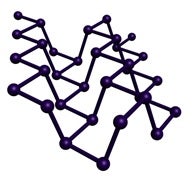Phospherene: A two-dimensional semiconductor
Antonio H. CASTRO NETO (Group Leader, Physics ) () August 03, 201403 Aug 2014. NUS physicists are studying a two-dimensional (2D) form of phosphorus called phospherene.
The race for the discovery of 2D materials has been intense since graphene was isolated for the first time in 2004. Although graphene is amazing, it has one major drawback: it is a metal and cannot be readily used in digital electronics and most materials studied showed poor electronic characteristics. In January 2014, a theoretical paper written by Professor Antonio CASTRO NETO and colleagues at the Graphene Research Centre and the Department of Physics in NUS has proposed a new 2D semiconductor based on phosphorus. Black phosphorus is a layered material and each layer is called phospherene (see Figure). Since this work appeared, a number of experimental groups, including ones at NUS, have started to work on this material. The results appear promising: phospherene shows extraordinary electronic and optical properties.
2D semiconductors can potentially be used in a plethora of applications in atomically thin, flexible, electronic applications: transistors, diodes, sensors, lasers, light-emitting diodes, photocells, solar cells, Hall effect sensors, integrated circuits, microprocessors, random-access memories, among others. All these devices are part of our way of living. 2D materials can make them smaller, lighter, faster, more energy efficient, wearable and cheaper to produce.
“2D materials science and technology is one of the most important frontiers of research worldwide,” says Professor CASTRO NETO, “Phospherene is on its way to revolutionize modern electronics. Phospherene, made out of pure phosphorus atoms, is making the headlines because of its amazing electronic properties. It can be used in applications where graphene cannot be used directly.”

Image shows a crystal structure of phospherene which has an accordion shape and it is made out of pure phosphorus. (Picture credit: AH CASTRO NETO)
References
- AS Rodin, A Carvalho and AHC Neto “Strain-induced gap modification in black phosphorus.” Physical Review Letters 112 (2014) 176801.
- L. Li et al. “Black phosphorus field effect transitors.” Nature Nanotechnology 9 (2014) 372.
- H. Liu et al. “Phospherene: a new 2D material with high carrier mobility.” ACS Nano 8 (2014) 4033.
- SP Koenig et al “Electric field effect in ultrathin black phosphorus.” Applied Physics Letters 104 (2014) 103106.


